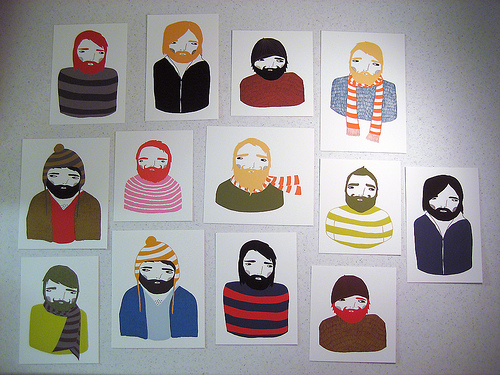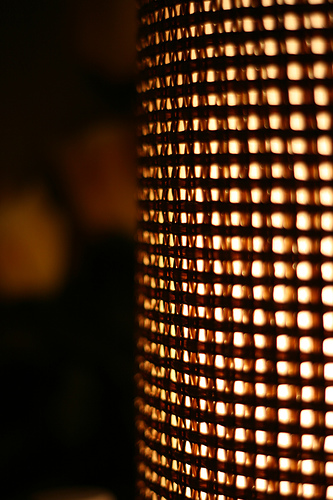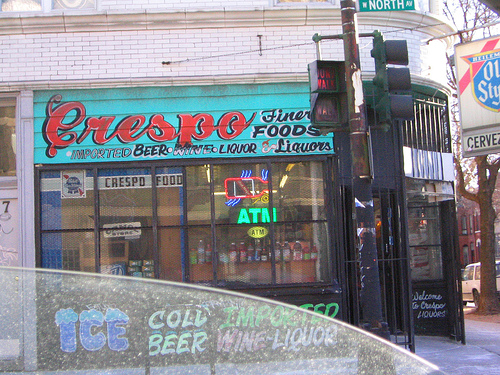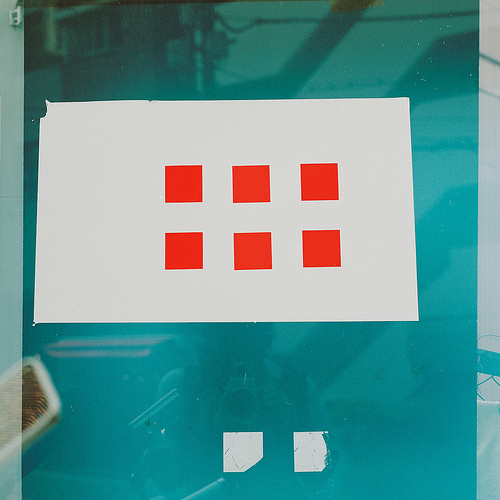Apparently these will be for sale on Etsy. I’m filing this under “knitting” because the stripes are giving me a yarn urge.
Tag: colours
Ernst Haeckel, categorization, sets of sets, primary colours, dog tv
I fell into a bit of a well of naturalism and anatomy links, and ended up wanting to read Stuffed Animals and Pickled Heads: The Culture and Evolution of Natural History Museums, although I’m pretty sure it isn’t as critical or curious as I want it to be. One review quotes this tedious oversimplification as a “philosophical insight into the scientific and human impulse to categorize.”
“To have a concept… is to have its negation already in tow…. There is a class of things called ‘dog,’ and there is a class of things (quite substantial, in fact) that are ‘not-dog.’… Language and thought cannot really function without this most basic tool for carving up reality.”
Never heard of fuzzy continuums and the rewards of using them, I guess? Odd, since natural history museums are full of ambiguous specimens (two headed mutant dog, alleged dog-cow hybrid, newly discovered tentative dog, etc) that illustrate quite nicely the space between dog and not-dog. Sort of dog. Possible dog. Both dog and yet not dog. Natural history museums are pretty much ground zero for failed categorization schemes and fuzzy margins, sets that are more complicated than somebody was hoping they would be. Maybe the quote is just out of context. There are a lot of ellipses in there.
To balance out the sad saga of binary categories in science, I like to think about primary colours. These seem like a life-affirming, pro-ambiguity, scientific success. Primary colours are sets of colours that are chosen to maximize the usefulness of the spectrum between them. A noble, everybody-wins way to think about categorization, and also an easily visualized example of information organized into multiple overlapping continua. Wikipedia points out that “Any choice of primary colors is essentially arbitrary; for example, an early color photographic process, autochrome, typically used orange, green, and violet primaries.” Concrete! Maybe this is because colour science is so bluntly tied up in perception and perspective. It has to be aware of observer bias and intention, because it is about observing. My favourite bit of that Wikipedia page:
If a human and an animal both look at a natural color, they see it as natural; however, if both look at a color reproduced via primary colors, for example on a color television screen, the human may see it as matching the natural color, while the animal does not; in this sense, reproduction of color via primaries must be “tuned” to the color vision system of the observer.
I wonder how long it will be before someone makes a TV for dogs, with two kinds of pixels instead of RGB. Or TV for bees, with four kinds.
Good looking light pattern
Stripes and stripes and squares.

Excessive red and blue in my kitchen, being impressive, calendar trivia…

For a moment I was feeling disappointed that I hadn’t come up with any simple theme for the photos I’ve been posting this week. (I don’t know if anyone even noticed them, but the matching sets of red and blue and crafty ideas and so on were making me more comfortable.) I got to thinking about the ways I use gimmicks like that whenever I make things, as a way to add automatic value to whatever I produce. Obvious extra effort. If nothing else, the project will look like a lot of work, which is impressive in certain ways, by default. I’m trying to stop doing that automatically and cut to the chase more. Be more honest instead of more impressive. Probably every adult thinks about this at least a little bit, in some context. I thought I was doing alright with this personal growth project, but then at a festive feast with my extended family, a cousin’s friend commented that I seemed well read. That’s probably my number one trying-to-impress-you habit, being smart. It’s complicated, because I do like to learn things and I do like to share what I find out and not hoard it, but if I want to be your friend I will almost surely start telling you a lot of fanciful trivia related by a larger theme instead of, for example, asking you to tell me about things you seem to know that I don’t. Reading about DIY education is helping me work on this. It makes nonconsensual teaching really, really embarrassing.
So. As my early morning mind-map hopefully explains, I was all set to embrace the non-patterned nature of my really low-effort holiday posts. Then I got to thinking about how much I love the way the last week of the calendar year can get divorced from daily reality and kind of out of time. Students and lots of workers are on holiday from their regular schedules, you never know when shops are going to be open, many households have visitors or go visiting, a lot of people eat really strangely… Regular patterns don’t hold. It reminds me of an ancient Roman intercalary festival that I can’t remember the name of. So now of course, that’s my theme for this week’s little photos. Intercalary disorder. I think this sort of doubly violates my goal of not acting so impressive.
Orange and brown, knitted mitts
I’ve seen many versions of Eunny Jang’s endpaper mitts online, but this is the first pair that made me want to knit some. Good colours! I previously experienced that diamond pattern as kind of fussy and fancy, but the orange and brown version is more my speed. Geometric and, you know, orange. I would knit these, and then I would make kung fu hands like craftster mozilla in the photo there.
Greens, facial expression, halves
Red and blue, mainly the wall actually
Red and blue, another handpainted sign
Red and blue, handpainted sign
Red and blue, graffiti
i wonder if the heart symbol is a joke. i’m also having a lot of cognitive dissonance concerning those substitute/symbolic Os and the idea that letters are things, not pictures of things, while words are not things, but pictures of things. this leaves the graffiti approximately nowhere, but i still like the colours.









